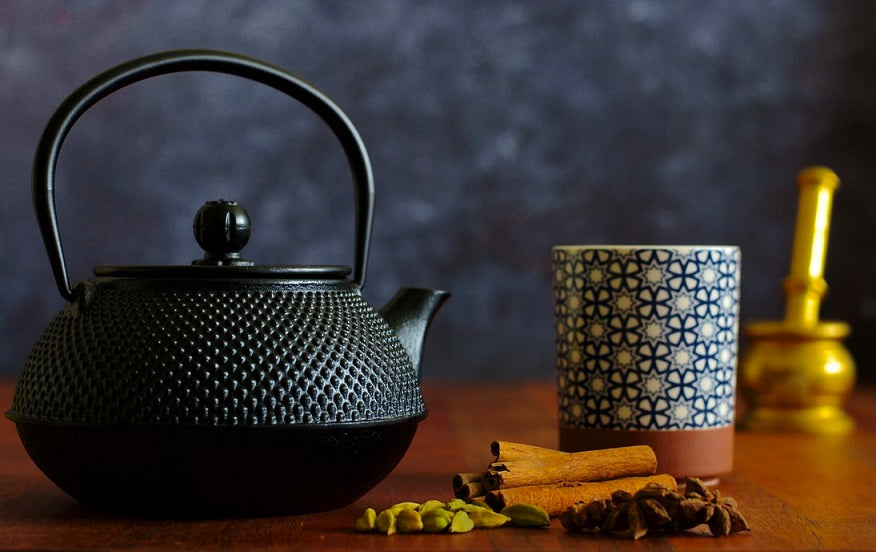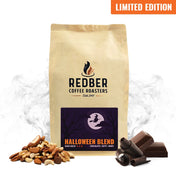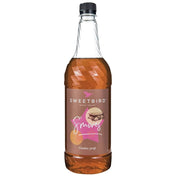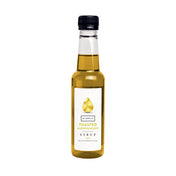Ancient China: The Birthplace of Tea
The history of tea dates to ancient China, 5,000 years ago. According to legend, in 2732 B.C. Emperor Shen Nung discovered tea when leaves from a wild tree blew into his pot of boiling water. He was immediately interested in the pleasant scent of the resulting brew and drank some. Legend says the emperor described a warm feeling as he drank the intriguing brew, as if the liquid was investigating every part of his body.

Emperor Shen Nung (picture: nybooks.com)
Shen Nung named the brew "ch'a", the Chinese character meaning to check or investigate. In 200 B.C. a Han Dynasty Emperor ruled that when referring to tea, a special written character must be used illustrating wooden branches, grass, and a man between the two. This written character also pronounced "ch'a" symbolized the way tea brought humankind into balance with nature for the Chinese culture.
China's Tea History
The popularity of tea in China continued to grow rapidly from the 4th through the 8th century. No longer merely used for its medicinal properties, tea became valued for everyday pleasure and refreshment. Tea plantations spread throughout China, tea merchants became rich, and expensive, elegant tea wares became the banner for the wealth and status of their owners.
The Chinese empire tightly controlled the preparation and cultivation of the crop. It was even specified that only young women, presumably because of their purity, were to handle the tea leaves. These young female handlers were not to eat garlic, onions, or strong spices in case the odour on their fingertips might contaminate the precious tea leaves.
Invention of Black Tea
Up to the mid-17th century, all Chinese tea was Green tea. As foreign trade increased, though, the Chinese growers discovered that they could preserve the tea leaves with a special fermentation process. The resulting Black tea kept its flavour and aroma longer than the more delicate Green teas and was better equipped for the export journeys to other countries.

Tea in Modern Day China
Tea has remained an integral part of Chinese culture for thousands of years; it was popular before the Egyptians built the great pyramids and was traded with Asian countries even before Europe left the dark ages. The importance and popularity of tea in China continues in modern day and has become a symbol of the country's history, religion, and culture.
Today, students compete to attend the very selective and exceptional Shanghai Tea Institute. The highest level students are required to play the traditional Guzheng stringed instrument, perform a flawless tea-serving ceremony, speak a foreign language to entertain overseas guests, and distinguish between about 1,000 different types of Chinese tea...to date fewer than 75 students have been awarded a Tea Art certificate. There is also an entire amusement park called the Tenfu Tea Museum - China's equivalent of Disneyland - that honours the Chinese tea-drinking traditions.
Tibet's Tea History
The Chinese had introduced tea to Tibet by the dawn of the 9th century. Tibet's rugged climate and rocky terrain made cultivation of their own plants difficult, so tea had to be imported from China via yak caravan. The long, tiring journey into Tibet by yak took one year and was threatened not only by the dramatic terrain of some of the highest mountains in the world, but by tea-seeking thieves and pirates. To keep up with the high Tibetan tea demand, nearly two to three hundred tea-laden yaks entered the country daily.
Tea became so popular in Tibet and the surrounding areas that it was used as a form of currency. Compressed tea was a generic form of payment for almost anything, and workers and servants were routinely paid in this way.
Traditionally, Tibetan tea is made by boiling the leaf for about half an hour before passing the liquid through a strainer made of horsehair (sometimes today made of plastic) into a long wooden container. Traditionally, yak butter and salt are added to the tea and churned until emulsified. These additives help replace the fat and salt lost by those living in the high-altitude regions of the Himalayan Mountains. Younger generations of Tibetans sometimes drink a variation of Indian Chai.
A Tibetan Staple
Tea remains a Tibetan staple, with per-person consumption of up to forty cups or more daily. Tibetan etiquette dictates that no guest should go without tea and that his or her cup can never be empty.

Tibetan Butter Tea (source Wikipedia)
Japan's Tea History
In the early ninth century, Japanese visitors to China were introduced to the values and traditions of tea. The Buddhist monk Dengyo Daishi is credited for bringing Chinese tea seeds to Japan when he returned from his studies abroad. Tea became an integral part of Japanese monastery life; monks used tea to help stay alert during meditation sessions. By the early 1300's tea gained popularity throughout Japanese society, but its early religious importance permanently coloured the meaning and value the Japanese associate with tea and directly influenced the Japanese Tea Ceremony.
The Japanese Tea Ceremony
The sacred Japanese tea ceremony, called "Chanoyu", evolved in the late 15th century under the influence of the Japanese philosophies of Zen Buddhism. The ceremony places supreme importance on respecting the act of making and drinking tea. Zen Buddhism honours the essential elements of Japanese philosophy (harmony, purity, respect, and tranquillity) during Chanoyu. The tea ceremony was so important that special tea rooms were built in backyard gardens, and proficiency in the tea ceremony was a required for women to marry.

Japanese Tea Ceremony (source: Truly Experiences)
Traditional Japanese Tea
The tea used in Chanoyu was made by whisking water into potent ground green tea called "Matcha". Although unusual to the Western palate, the Japanese preferred the fresh, green flavours of Matcha to the steeped tea brewing methods. Steeped tea became popular again in Japan in the late 1730's when experimental tea processors discovered that steaming the leaves to stop fermentation produced a greener and more flavoursome tea that more closely resembled the fresh, potent flavours characteristic of Matcha.

Matcha
Tea in Modern Day Japan
Today, tea is completely infused (no pun intended) in Japanese culture. Tea is served with every meal and used to greet to every guest. Bottled tea is found in vending machines and shops even peddle "Green Tea" flavoured ice cream.
Because of the limited land area (Japan is a series of mountainous islands, after all), intricate terraces are carved out of the mountainsides to grow tea. The tea industry in Japan is the most technologically advanced in the world. Currently, Japanese plantations use many specialised machines in the production of tea in direct contrast to the ancient, hand-processed methods of tea production still widespread in China. Because of their different taste preference, the Japanese have engineered their tea to taste greener, more potent, and less sweet than that produced in China.
Russia's Tea History
In 1618, the Chinese presented a gift of tea to Tsar Alexis of Russia. Everyone was curious about the new beverage and tea quickly gained popularity. A camel caravan trade route emerged to transport tea into the country. This caravan covered 11,000 miles and took one year to travel by camel. To keep the tea-hungry Russians satisfied, 6,000 camels - each carrying six hundred pounds of tea - entered Russia each year. In 1903 the camel caravan was replaced by the famous Trans-Siberian Railway, which slashed the transportation time from one year to just over a week.
Europe's Tea History
The Portuguese and Dutch first imported tea into Europe in 1610...Rembrandt was just 4 years old! England's dance with tea did not start until 1662 when King Charles II married the Portuguese princess Catherine of Braganza. Britain's new Queen had always loved tea and brought with her, as part of her dowry, a chest of fine Chinese tea. She began serving the tea to her aristocratic friends at Court, and word of the exotic Royal beverage spread quickly.
Tea as a Status Symbol
As an imported luxury, only the wealthy could afford to drink tea. The least expensive pound of tea available cost the average labourer about a month's worth of wages. The lofty tea prices made tea highly fashionable and elitist. The ability to serve and drink tea with elegance and skill marked social status and indicated good breeding and intellect. To that end, many wealthy 18th century English and Dutch families had paintings made of the family having tea.
The "Afternoon Tea"
Afternoon tea, still a popular British institution, is credited to Anna, the 7th Duchess of Bedford, who complained of the long gap between a light breakfast and a late evening meal. To appease her cravings, she advised her house cleaner to bring a pot of tea and light refreshments to her room. Anna soon began to invite friends to join her for afternoon tea...and the trend spread quickly.
The "High Tea"
High tea is a very much a different thing than the Afternoon tea. High tea, though it sounds more elite, is a 19th century working class custom. High tea is served later (around 6:00 PM) and consists of a full dinner meal for the common people. High tea is served alongside meats, fish or eggs, cheese, bread and butter, and cake. High tea is more of a man's meal, while Afternoon tea is more of a lady's social diversion.

High Tea (source: Foodie Hong Kong)
The Role of Tea in Globalization
The Dutch dominated the tea trade until 1678 when the British began importing tea on a commercial scale. The British Royal family, seeking full control and profits over trade, chartered the East India Company and granted it a monopoly on all trade throughout Asia and Eastern Africa. The East India Company quickly became the most powerful monopoly the world has ever known - and tea was its primary commodity. They were given the right to acquire territory, coin money, keep armies and forts, punish lawbreakers, form foreign alliances, and even declare war.
The reign of the East India Company continued until the British Parliament declared the trade routes open to competition in 1833. There were, however, many lasting effects of the centuries of dominance. The British East India Company changed the world: They claimed Hong Kong, Singapore, and India as British colonies, and prompted a global economy...all because of tea.
India's Tea History
The Opium Wars
As tea consumption grew, Britain's exports could not keep up with the demand for tea imports. The Chinese were more interested in silver than in cotton, Britain's main export. Finding enough silver to trade for tea became increasingly difficult, however, so the British turned to growing opium in its large Asian colony...India. The scheming British sent opium to China across the Indian border in exchange for silver, then traded the same silver back to China for tea. The illegal opium scheme worked until 1839 when a Chinese official sent 20,000 chests of opium to a watery grave in a sea near Canton. A year later, Britain declared war on China and China retaliated by placing a strict embargo on all exports of tea.
Tea Plantations in India
China was hesitant about trading with the West even before the Opium Wars began. China believing their nation to be self-sufficient and took steps toward isolation. The difficulty of obtaining Chinese tea prompted Britain to explore other alternatives...like growing their own tea.
The climate and high altitudes of Northern India made it a promising location for tea cultivation. Also, explorers had discovered indigenous tea plants growing in Assam, India as early as 1823. Before long, Indians became experts on growing exceptionally beautiful tea plants, but lacked knowledge on tea processing. Robert Fortune, a Scottish botanist, is credited for spying on China's ancient sacred tea processing techniques and returning to India with knowledge, equipment, and a small team of experienced Chinese growers.
North America's Tea History
It is no surprise that early North America, colonized by Europe, was a tea-drinking continent. Europe's same traditions and rules of etiquette crossed the Atlantic; Teahouses and elegant silver and porcelain tea accessories were popular in the new cities of New York, Boston, and Philadelphia.
The American Revolution
By the second half of the 18th century, tea constituted the single largest and most valuable commodity exported by Britain. The British government ordered a specific "tea tax" to capitalise off its popularity in America. Greed prevailed and the tax rate gradually reached 119%, more than doubling the initial cost of tea as it entered the American wholesale market.

Tea tax in Us (History.com)
In defiance, the American ports refused to allow any dutiable goods ashore. This resulted in the infamous Boston Tea Party, the British government's closure of Boston harbour, and the arrival of British troops on American soil. This series of events marked the beginning of the American War of Independence...and America's preference for coffee. Boycotting tea became an act of patriotism.
American Advancements in Tea Drinking
The United States is still responsible for a few major changes in the tea industry. At the St. Louis World Trade Fair of 1904, a group of tea producers organized a special tea pavilion and offered cups of hot tea to all attendees. The unusually sizzling summer temperatures prompted the man supervising the deserted booth to pour tea into glasses packed with ice cubes. Customers lined up to try the invention - iced tea. Today, the U.S. guzzles almost 50-billion glasses of iced tea in a single year, which accounts for more than 80% of all tea consumed stateside.
Tea bags were also developed in the United States, albeit by accident. In 1908, a New York tea merchant sent samples of his product sealed in silk bags to restaurants and cafes throughout the city. After some time, he discovered that the restaurants were brewing his tea directly in the silk bags to save time. This method of brewing immediately caught on.
Tea in Modern America
Even though tea is the most popular drink in the world (besides water), it has only recently been on the rise in the United States. Today, thousands of Americans are adding tea into their healthy diets or substituting tea for coffee and soft drinks.
Sources:
Coffeeteawarehouse.com
Bbc.co.uk
Inthekitchen.org
Brewedleaflove.com




